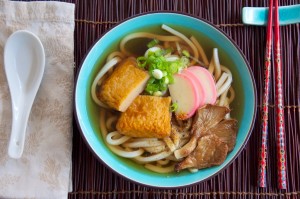 UDON IS AN IDEAL vehicle for wild mushrooms, especially oysters. The dashi broth, with its main ingredients of kombu (dried kelp) and katsuobushi (bonito flakes), might be the most famous example of umami in action. Now add some sautéed oyster mushrooms to the broth and you’re unlocking doors to very deep taste pleasures.
UDON IS AN IDEAL vehicle for wild mushrooms, especially oysters. The dashi broth, with its main ingredients of kombu (dried kelp) and katsuobushi (bonito flakes), might be the most famous example of umami in action. Now add some sautéed oyster mushrooms to the broth and you’re unlocking doors to very deep taste pleasures.
In the Pacific Northwest, look for oyster mushrooms in riparian areas on dead hardwoods, notably red alder and cottonwood (the host tree will be different elsewhere). Downed trees are a good bet, but oysters will also grow on standing trees, sometimes high enough off the ground to require a fireman’s ladder. What? You don’t have one of those? Best look on fallen logs then.
4 cups dashi *
2 tbsp soy sauce
2 tbsp mirin
1 tsp sugar
1/4 tsp salt
12 oz udon noodles
1 green onion, thinly sliced
1 handful oyster mushrooms, sautéed
cooking oil
fish cake (optional)
Shichimi tōgarashi (optional)
1. In a pot combine dashi broth*, soy, mirin, sugar, and salt. Bring to boil and lower heat.
2. Cook udon noodles separately according to instructions, drain, and rinse with cold water. I use frozen udon that comes in individual serving sizes, with several servings to a package.
3. Saute oyster mushrooms in a little oil (I used a mix of canola and sesame).
4. Ladle udon and broth into bowls. Garnish with sautéed oyster mushrooms, green onion, and optional toppings, such as fish cake. Season with a sprinkling of Shichimi tōgarashi if you like.
Serves 2
* Dashi Broth: Find dashi ingredients at your local Asian grocer. You can use pre-mixed dashi packets for convenience, or the ingredients below:
4 1/2 cups water
20 grams kombu (dried kelp)
2 loose cups (about 25 grams) katsuobushi (bonito flakes)
1. Soak kombu in cold water for minimum 15 minutes.
2. After soaking, heat water until nearly boiling. Turn off heat and remove kombu. Stir in katsuobushi and steep for 10 minutes.
3. Pour broth through a fine mesh strainer lined with cheesecloth or paper towel. Save kombu and katsuobushi to make a second dashi broth, known as niban-dashi, which is especially useful for miso soup.

